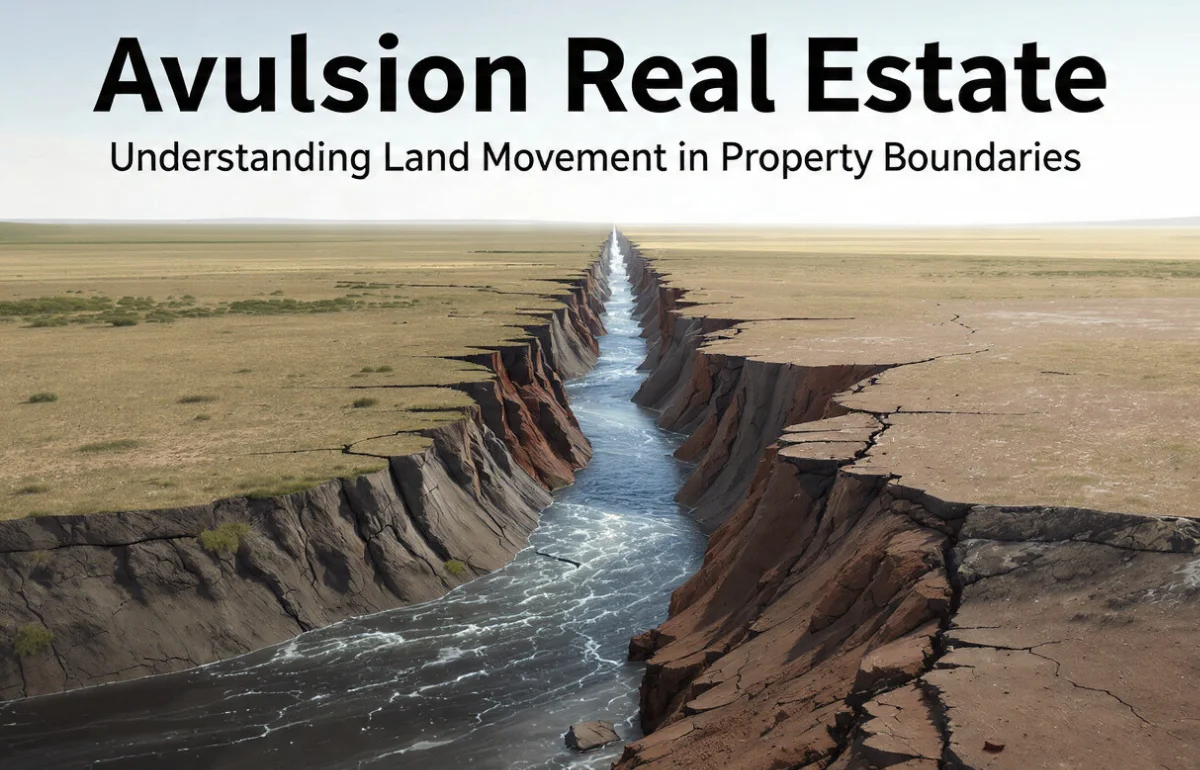
Have you ever heard of avulsion real estate and wondered what it means? If you own land near a river, lake, or coastline, this term can directly affect your property rights. Avulsion real estate refers to sudden, natural land changes — and knowing how it works can save you from major legal or financial headaches.
Legal Meaning of Avulsion in Real Estate
In simple terms, avulsion real estate describes a situation where land is suddenly moved, added, or taken away by natural forces such as floods, hurricanes, or earthquakes. The key factor is suddenness. Unlike accretion, which happens gradually as soil builds up over time, avulsion is abrupt — often occurring overnight.
For instance, imagine owning land beside a river. After a violent storm, the river shifts course and sweeps away a section of your property. That’s avulsion. However, if the river slowly changes direction over several years, that’s accretion. Understanding this difference helps you protect your property boundaries under avulsion real estate laws.
Avulsion vs. Accretion: The Main Differences
The difference between avulsion and accretion is critical in avulsion real estate because it determines whether your property boundary legally changes. Here’s a quick comparison:
| Aspect | Avulsion | Accretion |
|---|---|---|
| Nature of Change | Sudden and noticeable | Gradual and slow |
| Cause | Natural disasters, floods, or earthquakes | Continuous deposit of soil or sediment |
| Ownership Impact | Ownership remains with the original owner | Ownership may shift with land changes |
| Legal Treatment | Boundaries stay as before the event | Boundaries move with the land |
| Example | A river suddenly shifts course after a storm | Riverbank slowly expands over decades |
In short, avulsion real estate keeps property boundaries intact even after a dramatic natural change, while accretion alters them over time.
Legal Implications of Avulsion Real Estate
The legal side of avulsion real estate is fascinating and often misunderstood. When avulsion occurs, the law generally holds that property ownership does not change. Even if a flood separates part of your land, you still legally own it — though physically it might appear elsewhere.
However, disputes can arise in the following cases:
-
Inaccurate or old land survey records
-
Disputes over property lines among neighbors
-
Government or public land involvement (like rivers or beaches)
In such cases, courts rely on historical maps, expert surveyors, and state laws to resolve who owns what. Hiring a real estate attorney familiar with avulsion law can help clarify your rights and avoid costly litigation.
Avulsion and Waterfront Properties

If you own waterfront land, understanding avulsion real estate is essential. Rivers, lakes, and coastlines are constantly changing, but not all changes affect ownership. For property owners:
-
Avulsion keeps legal boundaries stable, even if the shoreline moves.
-
You cannot claim new land formed by the sudden water retreat.
-
You don’t lose ownership of land suddenly eroded by a flood.
This stability helps protect property owners from losing valuable land due to unpredictable natural events.
Avulsion Real Estate and Property Transactions
When buying or selling property, avulsion real estate can play a major role in verifying accurate boundaries and titles. Here are a few areas where it matters:
1. Title Verification
Always check land titles and surveys to ensure they match the current topography. Avulsion might cause differences between physical land and recorded deeds.
2. Insurance Considerations
Many standard homeowner or flood insurance policies exclude avulsion events. Buyers should ask their insurers whether they cover avulsion real estate damage or if special coverage is needed.
3. Disclosure Requirements
In some jurisdictions, sellers must disclose whether a property has a history of avulsion or flooding. Buyers should always review these disclosures before making an offer.
How to Protect Yourself in Avulsion Real Estate Situations
While you can’t prevent nature’s power, smart steps can minimize risk and confusion:
-
Order an updated property survey after any flood or earthquake.
-
Keep accurate records of your property’s boundaries.
-
Use durable boundary markers visible even after natural events.
-
Consult legal professionals who specialize in land-use and avulsion law.
-
Review local zoning and riparian rights laws if you live near water.
Taking these actions ensures your land ownership remains clear, no matter what happens.
Real-World Example of Avulsion Real Estate

A well-known example of avulsion real estate occurred along the Mississippi River, where floods in the early 1900s dramatically changed the river’s course. Despite land being physically relocated, courts ruled that ownership boundaries stayed as they were before the flood — a textbook case of avulsion law protecting original property rights.
Conclusion: Why Avulsion Real Estate Knowledge Matters
Understanding avulsion real estate isn’t just for lawyers or surveyors — it’s vital for any property owner. Sudden natural changes can physically move land, but not necessarily change who owns it. By staying informed about avulsion real estate principles, you can safeguard your boundaries, avoid disputes, and make smarter property decisions.
If you live near water or plan to buy waterfront land, consult a licensed surveyor or real-estate attorney to verify your boundary lines today. It’s a small step that can prevent big problems later.
FAQs
1. What is avulsion in real estate?
Avulsion in real estate refers to the sudden loss or addition of land caused by natural forces like floods or earthquakes. Ownership usually remains with the original landowner.
2. How is avulsion different from accretion?
Avulsion occurs suddenly, while accretion happens gradually over time. In avulsion, property boundaries remain fixed, but in accretion, they shift naturally with the land.
3. Does avulsion affect property ownership?
No. Even if a flood or earthquake changes the land’s shape, ownership remains with the original landowner under avulsion law.
4. What should I do if my property is affected by avulsion?
Consult a licensed surveyor and real estate attorney to assess your property lines, confirm legal boundaries, and maintain ownership documentation.
5. Is avulsion covered by insurance?
Most standard insurance policies exclude natural land changes caused by avulsion. Consider additional flood or disaster coverage to protect your property.
I’m Salman Khayam, the founder and editor of this blog, with 10 years of professional experience in Architecture, Interior Design, Home Improvement, and Real Estate. I provide expert advice and practical tips on a wide range of topics, including Solar Panel installation, Garage Solutions, Moving tips, as well as Cleaning and Pest Control, helping you create functional, stylish, and sustainable spaces that enhance your daily life.
